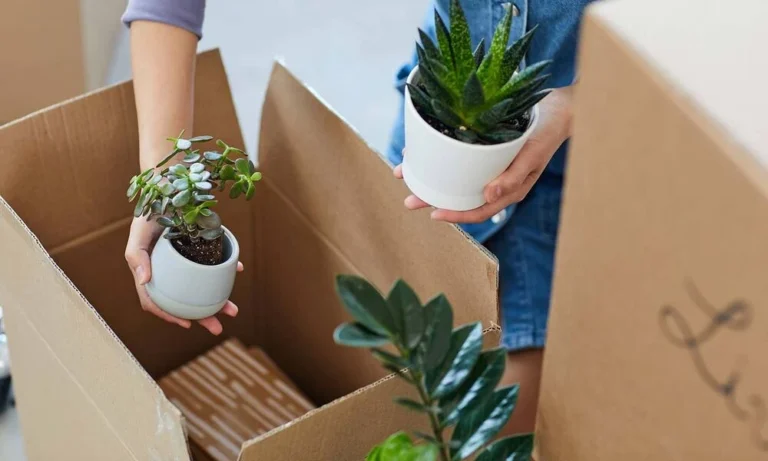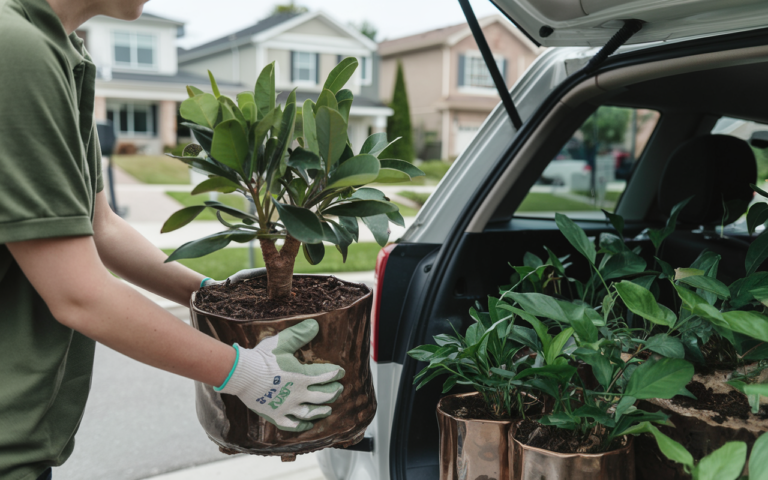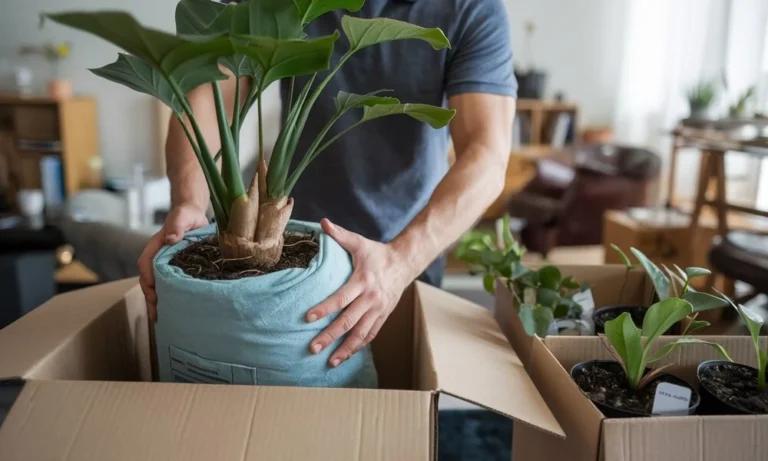How to transport plants when moving long distance can be a challenging task for many plant owners. Ensuring the safe arrival of plants over long distances involves considering various factors such as temperature, humidity, light, and handling. Improper transport can lead to stress, damage, or even the death of the plants. This makes it crucial to understand the best practices and strategies to maintain their health during the journey. Proper plant transport is essential for their survival, as plants are sensitive to changes in their environment and require special care to adjust to new conditions.
Why Moving Plants Requires Special Care

Fragility During Transit
Due to their fragility, plants are readily harmed in transit. Roots, stems, and leaves need protection from jolts, tipping, or temperature changes.
Local vs. Long-Distance Moves
Local moves are shorter and less stressful, but long-distance moves expose plants to more risks like temperature fluctuations and dehydration.
Impact of Temperature and Humidity
Extreme temperatures and low humidity can harm plants, causing dehydration, shock, or fungal growth. Keeping plants at a stable temperature is essential.
Reducing Stress
Stress from the move can lead to leaf drop or illness. Proper packing, hydration, and protection from harsh conditions are key to moving plants without killing them. For moving services in Los Angeles trust only Chamomile Go.
How to Care for Plants While Moving

Watering
Before the Move:
Water your plants a day or two before moving with plants. This helps ensure they are well-hydrated without being waterlogged. Avoid watering them right before the move, as excess water can cause the soil to shift and make a mess.
During Transit:
While moving with plants, it’s important to avoid overwatering. Don’t let the soil get soggy, but keep it damp enough. If you’re traveling long distances, you can place a damp cloth or paper towel around the roots to maintain moisture without dripping.
Light and Temperature
Proper Lighting:
Before moving with plants, ensure they are not in direct sunlight for long periods as this can stress them out. Try to keep them in indirect light or a shaded area. During the move, avoid exposing them to bright lights for extended times to reduce stress.
Temperature Protection:
To maintain a safe temperature during the journey, avoid leaving plants in hot or cold environments. If you’re traveling by car, keep the plants in the passenger compartment, as the trunk can get too hot or cold. For long-distance moves, consider insulating the plants using bubble wrap or blankets to maintain a consistent temperature.
Packaging
Packing Plants Safely:
When learning how to move with plants, packaging is crucial. Start by gently removing the plant from its pot to prevent damage. Wrap the root ball in damp newspaper or a plastic bag to hold moisture and protect it from drying out.
Using Boxes and Cushions:
Place the wrapped plants inside sturdy boxes that are slightly bigger than the plant to allow for some movement. Use crumpled newspaper or packing peanuts to cushion the plant and prevent it from shifting or breaking during transit. Make sure the box is ventilated to avoid heat buildup.
How to Move with Plants: Planning Ahead
Restrictions on Transporting Plants:
Before moving with plants, check local regulations regarding plant transport. Some states or countries have restrictions on moving plants across state lines or internationally to prevent the spread of pests and diseases. Research and make sure your plants meet all necessary requirements, including documentation and inspections.
Pest Inspections:
Many regions require pest inspections before transporting plants. Make sure your plants are pest-free and obtain any required certifications to avoid delays or fines during transit. This is particularly important for long-distance or international moves.
Transport Options
Personal Car:
Transporting plants in your personal car is a good option for local moves. You have control over temperature and light conditions, which can help keep the plants comfortable. However, this method can be limited by the number of plants and the space in your car.
Professional Movers:
Professional moving companies may offer plant transport services, especially for long-distance moves. They can provide the expertise needed to pack and protect plants during the journey. However, this option can be expensive, and not all movers may handle plants with the same level of care.
Shipping Plants:
Shipping plants via a courier is a practical option for long-distance moves. However, this method can expose plants to longer transit times and potential temperature extremes. It’s important to use a reliable courier and consider express shipping to minimize risks.
Pros of Each Method
Personal Car:
Pros: Cost-effective for minor adjustments and control over circumstances.
Professional Movers:
Pros: Expertise in handling plants, convenient for large moves.
Shipping Plants:
Pros: Convenient for long-distance moves, good for a large number of plants.
Planning ahead by considering these transport options and regulations will ensure that you move with plants safely and smoothly.
How to Transport Tall Plants in Car

Securing Tall Plants:
When figuring out how to move with plants, especially tall ones, securing them properly in the car is key to preventing damage. To lessen weight and stop soil moving, try to take the plant out of its pot. Wrap the root ball in a plastic bag or damp newspaper to keep it secure and moist.
Tips for Preventing Damage:
To prevent damage to the plant and pot, place the plant in a sturdy container or box. If the plant can’t be removed from the pot, secure the pot in a box or crate to avoid tipping over. You can also use packing materials like bubble wrap or towels to cushion the plant. Ensure the plant isn’t leaning against any sharp edges or other objects.
Creative Solutions
Fitting Tall Plants in Your Vehicle:
If you’re moving with plants in your car, and the plant is too tall to sit upright, try laying down the back seats to create more vertical space. You can also tilt the plant slightly or place it in the footwell to prevent it from being crushed by the ceiling. For larger vehicles, such as SUVs or minivans, you might be able to stand the plant up in the middle or back area, but always ensure it’s secure.
Alternatives for Larger Plants:
If the plant is too large to fit in your car, consider hiring professional movers who specialize in transporting plants, or rent a moving van. These options provide more space and reduce the risk of damaging your plant during the move.
During the Ride
Maintaining Plant Stability:
During the ride, ensure that the plant is stable and won’t tip over or slide around. Use ropes, bungee cords, or blankets to keep the plant in place, especially on longer trips. You can also create a custom stand to hold the plant upright and reduce the risk of it falling during transit.
Avoiding Harsh Conditions:
To protect your plant, avoid direct sunlight, air conditioning, and drafts. Sunlight can cause overheating, while air conditioning and drafts can lead to sudden temperature changes, stressing the plant. Keep the car at a comfortable temperature and avoid placing the plant near open windows or vents. For packing services in Los Angeles contact no other than Chamomile Go.
How To Transport Plants When Moving Long Distance
Watering:
Before you move with plants long distance, water them a day or two before the journey. This ensures they are hydrated but not overly moist. Avoid watering right before the move to prevent the soil from becoming too wet or messy.
Pruning:
Trim any dead or damaged leaves or stems to reduce the plant’s stress during the move. This also helps prevent any broken parts from causing damage to other plants.
Packaging:
To prevent damage, pack the plant carefully. Wrap the roots in a damp cloth or plastic bag and then secure them with bubble wrap or newspaper to prevent shifting. If possible, remove the plant from its pot and transport it in a plastic bag to reduce weight and prevent soil from spilling. If leaving the plant in its pot, secure the pot in a sturdy box with packing materials to prevent movement.
Choosing the Right Transport Method
Personal Vehicle:
If you’re moving with plants in your own car, keep the plants in the passenger area to maintain temperature control. Avoid leaving plants in the trunk or exposed to direct sunlight for long periods.
Professional Movers:
Hiring professional movers who specialize in plant transport is a great option for long-distance moves. They can ensure your plants are properly packed and handled during transit. Be sure to ask about their experience with plant transport and any additional care they provide.
Shipping:
If you’re shipping plants, choose a reliable courier service that handles live plants. Use express shipping to reduce transit time and ensure the plants are not exposed to unfavorable conditions for too long. Ensure the plants are packed securely in insulated boxes to prevent temperature extremes.
During the Ride
Temperature Control:
Maintaining a stable temperature is crucial when moving with plants over long distances. Avoid exposing plants to extreme temperatures—whether it’s too hot or too cold. If traveling by car, try to keep the plants in the cabin where the temperature is easier to control. For shipping, ensure the plants are in an insulated box to protect them from heat or cold.
Avoiding Stress:
Minimize the plant’s exposure to direct sunlight, drafts, or air conditioning, as these conditions can cause stress. Make sure to place them in a shaded area during stops or layovers. If using a moving van, keep the plants away from vents or direct sunlight.
After the Move
Once you’ve reached your destination, immediately place the plants in a safe location with appropriate lighting and temperature. Allow them some time to acclimate to the new environment, and check for any signs of stress or damage. Rehydrate the plants as needed and provide gentle care to help them adjust.
Conclusion
In conclusion, taking proper care of your plants during a long-distance move is crucial for their health and survival. By preparing ahead, packing securely, and protecting them from temperature changes, you can ensure a safe journey for your plants. Choosing the right transport method and minimizing stress during the move are key factors in their well-being. At Chamomile Go, we understand the challenges of moving plants and are here to help every step of the way. For any advice or assistance, don’t hesitate to contact us at +1 310-895-3517. We’d love to hear about your plant-moving experiences and offer support to make your transition smoother!
FAQs
How Do I Prepare My Plants For A Long-Distance Move?
To prepare your plants for a long-distance move, water them a day or two before the journey to ensure they are hydrated but not overly wet. Trim any damaged leaves and pack the roots securely in plastic or damp newspaper. If possible, remove the plants from their pots and use proper packing materials to protect the plant during transit.
What Are The Best Ways To Pack Plants For Long-Distance Transport?
For long-distance transport, wrap the plant’s roots in damp cloth or plastic to retain moisture. Use sturdy boxes or containers to secure the plants and prevent them from tipping over. Pack the plants with cushioning materials like bubble wrap or newspaper to minimize movement during transit.
Can I Transport Plants In My Car For A Long-Distance Move?
Yes, transporting plants in your car is a good option for long-distance moves, as you can control temperature and light. Ensure the plants are secure and avoid direct sunlight, air conditioning, or drafts during the ride. If the plant is too tall, consider laying down the back seats or tilting the plant to fit.
What Temperature Should I Maintain For Plants During The Move?
Plants should be kept at a stable, moderate temperature during the move. Avoid extreme temperatures (too hot or too cold), as they can cause stress or damage. Keep plants in a shaded area during transit, and if using a moving van, ensure they are insulated from temperature extremes.
Can I Ship Plants Long Distance?
Yes, you can ship plants long-distance using a reliable courier service. Be sure to use express shipping to minimize transit time and pack the plants securely in insulated boxes to protect them from extreme temperatures. Make sure to check any regulations on shipping plants to prevent delays.

